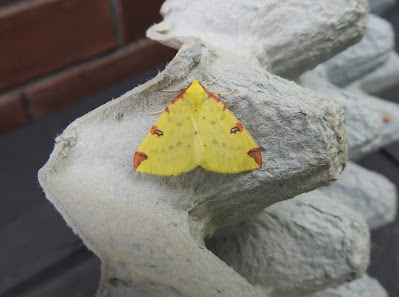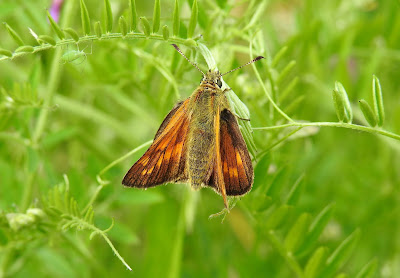What a busy ten days or so it's been since I last posted, and it feels like I have been here, there and everywhere, and that's probably because I have! All of my birding, or nearly all of it, of late, has been through work. But once all my breeding bird surveys finish at the end of June, I am hoping for a couple of months of relative quiet. But I am not going to complain.
At the end of the first week in June, I was at one of my sites that I have been surveying throughout the winter, and now I am in the process of completing a set of three breeding bird surveys, and this was visit two. It looks a lot different now with all the winter wheat well on its way, but the adjacent fresh water marsh still provides some interest.
I had been saying recently, that I hadn't seen a huge number of Whitethroats so far this spring, but since I said that, they have arrived in good numbers. In fact, on this morning, I recorded eight, including five singing males. You've got to be careful with Whitethroats when you are mapping territories as they move around quite a bit, and it's easy to record individuals twice. The only other warbler species I recorded were seven Sedge Warblers, and two of these were singing males.
Five Tree Sparrows called from one of the hedgerows, and I'm guessing that they would have been a family party, but I didn't see them well enough to see if any were juv's or not. On the subject of juvenile birds, I had six observations of Great Spotted Woodpeckers, and I say six observations, as the six birds I recorded could have been one or two of the same individuals moving around. Anyway, at least two of the Great Spots were juv's, including one that landed noisily on a branch above my head, but flew off as I raised my camera!
With an adjacent freshwater marsh, you would expect Reed Buntings, and I recorded six, including two singing males. Three Grey Herons were on the marsh, and the only raptor I had was a male Sparrowhawk.
The following day I was over at my former industrial site on the Humber estuary, and under clear skies with a light south-easterly breeze, I had a bit of a warbler fest. Nothing mega, but a singing Cetti's Warbler, three singing Chiffchaffs, two Willow Warblers (one singing), eight Sedge Warblers (seven singing), seven Whitethroats (five singing), six Lesser Whitethroats (four singing) and two Blackcaps (one singing and one female), made it on to the pages of my notebook.
The warblers really were the feature of the morning, but 40 Linnets was a good count. The site is perfect for them, and the numbers reflect the ideal habitat.
Last weekend, Gail, Alice and I finished off the boxes at our nest box scheme in Bowland, and we ringed the last brood of eight Pied Flycatchers that were too small the previous weekend.
Pied Flycatcher chick in Gail's hands We also checked the Spotted Flycatchers, and the five eggs were now five very small young, probably only hatched the day before. Alice and I returned today, and ringed five healthy Spotted Flycatcher chicks! A quick check on DemOn, and the last Spotted Flycatcher chicks ringed by the group was in 2010, and at this site in 2008. In fact, we have only ever ringed 29 Spotted Flycatchers, with 22 of these being pulli. So, to ring another five this morning was excellent, and it all adds to the conservation data generated for this declining red-listed species.
Spotted Flycatcher - adult with food above, and chick in Alice's hands below
I have operated my moth trap infrequently this year, mainly because of lots of early morning starts for bird surveys, but hopefully once June is out of the way, I should be able to run my light trap a few times a week throughout July and August. However, earlier this week I did run my trap on one night, and caught twelve moths of six species as follows:
Brimstone Moth - 2
Garden Carpet - 1
Heart and Dart - 6
Large Yellow Underwing - 1
Lychnis - 1
Common Marbled Carpet - 1
Towards the end of this week, I was back at my inland arable survey site, with an adjacent area of marsh, and it was fairly quiet. As you know, it's been a late spring, and normally you would expect a few juvenile birds out of the nest by now, but a lot of the summer migrants are still feeding dependant young in the nest.
I recorded five Tree Sparrows again in a similar area, and I recorded a whopping eleven Reed Buntings. Watching the Reed Buntings, it was obvious that some of them were nesting in the winter wheat, so let's hope that they manage to fledge their young before harvest!
Only three Whitethroats during my survey, but two Lesser Whitethroats were new in. They have certainly arrived later this year. Other than that, like I said before, it was quiet.
Yesterday I was back on Anglesey, and I was on site by 4:45 a.m. under clear skies, with quite a cold northerly wind. In fact, it was cold enough for five layers of clothing! Part of my survey at this site entails two hours of VP survey effort looking over the sea. It was quite busy with seabirds coming and going, commuting from their colonies to foraging areas, and the highlights included two Fulmars, 24 Manx Shearwaters, twelve Gannets, two Shags, nine Kittiwakes, an adult Med. Gull, twelve Sandwich Terns, a Common Tern, eight Arctic Terns, 48 Guillemots, seven Razorbills, five Puffins and seven Auk sp.
I had two Harbour Porpoises close in, which was brilliant, and I also had a mystery dorsal fin! A flock of Herring Gulls feeding on the sea off a close offshore rocky islet, where they nest, grabbed my attention, and amongst the feeding frenzy I had the briefest of views of a tall dorsal fin. It was for a split second only, and it disappeared completely. So,who the dorsal fin was attached to, I have no idea. It's like that sometimes.
Three species of raptor made an appearance during the morning; a male Sparrowhawk, a pair of Buzzards and a Kestrel.
A pair of Choughs was a mega sighting for me, but of course Anglesey is a Chough hotspot in the UK, so it wasn't really a surprise. I saw a pair perched up on a building, and they flew around calling when I walked past, and then I saw them later fly over me close to my VP. Two Ravens were present on site as well, and seeing them fairly close reminded me of just how big they are. At one point during my VP survey period, I picked them up flying from the offshore islet back to the mainland. I am guessing that they were visiting the Gull colony for a feeding opportunity!
I recorded 41 species during my survey, but other than 211 Herring Gulls, three Chiffchaffs, four Whitethroats and four Rock Pipits, the above were the highlights.
I'm going to finish off with a common butterfly species that I recorded for the first time (I think) in my garden this morning, and that's the Large Skipper (below), a female in fact. The caterpillar's main foodplant is Cock's-foot, and there is Cock's-foot in my mini-meadow. Hopefully we'll see some more of her, or others!


































